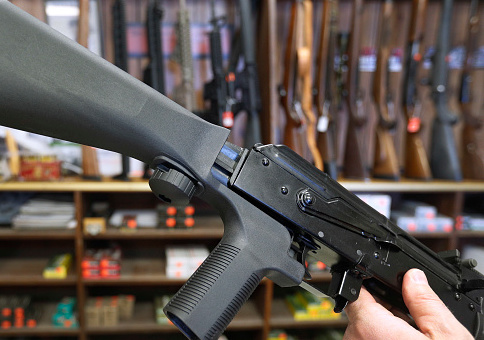The Department of Justice (DOJ) and Bureau of Alcohol, Tobacco, Firearms, and Explosives (ATF) announced on Tuesday they had initiated a review of the legality of bump-fire stocks.
"The Department of Justice has the duty to enforce our laws, protect our rights, and keep the American people safe," Attorney General Jeff Sessions said in a press release. "Possessing firearm parts that are used exclusively in converting a weapon into a machine gun is illegal, except for certain limited circumstances. Today we begin the process of determining whether or not bump stocks are covered by this prohibition."
The ATF began the regulatory process on Tuesday by submitting an Advanced Notice of Proposed Rulemaking to the Office of Management and Budget.
"We will go through the regulatory process that is required by law and we will be attentive to input from the public," Sessions said. "This Department is serious about firearms offenses, as shown by the dramatic increase in firearms prosecutions this year. The regulatory clarification we begin today will help us to continue to protect the American people by carrying out the laws duly enacted by our representatives in Congress."
Bump-fire stocks have come under scrutiny after they were used by a shooter in Las Vegas, Nev., to kill 58 people.
In 2010, the Slide Fire company requested an ATF review of their bump-fire stock. Its bump-fire stock, which is operationally similar to others on the market, helps a shooter physically pull the trigger of a semi-automatic rifle at a faster rate than would otherwise be possible. The stock is designed so a shooter can hold the rifle's grip with his shooting hand while placing his shooting finger on the trigger. The shooter then puts his support hand on the forward handguard and applies a forward pressure that allows the gun's trigger to be pressed into the shooting finger. That action fires the gun, which creates recoil that pushes the gun rearward. If the technique is done properly, the recoil will push the gun far enough rearward to reset the semi-automatic rifle's trigger and the forward pressure applied by the shooter's support hand will rebound the trigger back into the shooting finger firing the gun again. The cycle then repeats itself.
The bump fire technique can be accomplished without the use of a bump-fire stock or any other modification. The stocks are designed to facilitate a shooter in performing the technique.
In response to Slide Fire's requested review, the ATF determined that the company's stock was only a firearm part and not subject to regulation under the Gun Control Act of 1968 or the National Firearms Act of 1934.
"The stock has no automatically functioning mechanical parts or springs and performs no automatic mechanical function when installed," the ATF's letter stated. "In order to use the installed device, the shooter must apply constant forward pressure with the non-shooting hand and constant rearward pressure with the shooting hand. Accordingly, we find that the ‘bump-stock' is a firearm part and is not regulated as a firearm under the Gun Control Act or the National Firearms Act."
The National Rifle Association (NRA) called on the ATF to undertake a review of bump-fire stocks in October.
"In Las Vegas, reports indicate that certain devices were used to modify the firearms involved," top NRA executives Wayne LaPierre and Chris Cox said in October. "Despite the fact that the Obama administration approved the sale of bump fire stocks on at least two occasions, the National Rifle Association is calling on the Bureau of Alcohol, Tobacco, Firearms and Explosives (BATFE) to immediately review whether these devices comply with federal law. The NRA believes that devices designed to allow semi-automatic rifles to function like fully-automatic rifles should be subject to additional regulations."
If the ATF reverses its previous determination that bump fire stocks are firearms accessories and declares them "machine guns," it will cause the devices to immediately become regulated under the National Firearms Act, which would require registration with the agency and a $200 tax stamp on each device. The ATF has not announced how long the review will take or when it expects to publish its determination.
